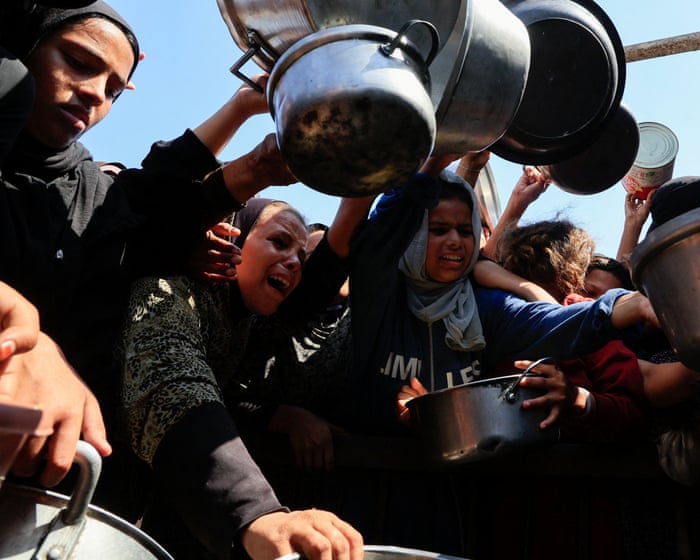UN-backed experts have declared that a “completely man-made” famine is underway in and around Gaza City, with worsening conditions threatening a sharp rise in deaths across the devastated territory.
The Integrated Food Security Phase Classification (IPC), a globally recognized body that measures food insecurity and malnutrition, confirmed that three key famine thresholds have been met, marking a major escalation of the humanitarian crisis in Gaza. Since its founding in 2004, the IPC has declared famine only four times, most recently in Sudan last year.
The report states, “This famine is entirely man-made and can be stopped and reversed. There is no more time for debate—starvation is already here and spreading fast. Everyone must understand that a large-scale, immediate response is essential. Any further delay, even by days, will lead to an unacceptable surge in famine-related deaths.”
It adds, “Unless a ceasefire allows humanitarian aid to reach everyone in Gaza, and unless food supplies and basic health, nutrition, water, and sanitation services are restored right away, preventable deaths will skyrocket.”
In July, the IPC warned that parts of Gaza were approaching famine but held off on a formal declaration due to insufficient data. Now, besides the famine in Gaza City—home to between 500,000 and 800,000 people—the report warns that Deir al-Balah and Khan Younis in central and southern Gaza are likely to face famine in the coming weeks. While data is still lacking for northern Gaza, aid officials believe conditions there are the most severe and are calling for urgent access to conduct a full assessment.
Ibtisam Saleh, 50, from Gaza City, said she and her son have been surviving on one meal a day, often going without. “We only have lentils to cook—nothing else. Yesterday, someone gave us a small bag of rice. I can’t eat from the food kitchens; it upsets my stomach, and I don’t have the strength to wait in line,” she told the Guardian.
To declare a famine, three conditions must be met: at least 20% of households face extreme food shortages, 30% of children suffer from acute malnutrition, and two out of every 10,000 people die daily from starvation.
This declaration increases pressure on Israel to ease the strict supply restrictions it has enforced during the 22-month conflict. Israel has rejected the report’s findings, calling them based on “Hamas lies promoted by biased organizations.” Prime Minister Benjamin Netanyahu has announced plans for a major new assault on Gaza City in the coming weeks, which aid officials warn would have catastrophic consequences for civilians.
Meanwhile, the Gaza Humanitarian Foundation (GHF), an Israel-backed group intended to replace previous aid distributors, has been involved in aid efforts. On Friday, aid packages were airdropped with parachutes over Deir al-Balah.
Amjad Shawa, director of the Gaza NGOs Network, based in Gaza City, said, “This is the worst and most critical stage in Gaza’s history, not just in this war. We are exhausted and sick. Without food, we can’t imagine what will happen next.”The UN and other aid groups are struggling to deliver enough food due to major logistical challenges. These include widespread looting amid a near-total collapse of law and order, ongoing Israeli military operations, administrative restrictions and bureaucracy imposed by Israel, and severely damaged infrastructure in Gaza.
Riham Kraiem, 35, who is living in a tent in Gaza City, said her 13-year-old son risks his life traveling to aid distribution points in northern Gaza, often returning empty-handed in his attempts to feed their family of 10. “My children’s health is now very poor,” she said. “There’s nothing nutritious for them to eat. I can’t provide proper food to support their bodies. My four-year-old daughter is getting worse—she’s malnourished and sick because of it.
“I have no food left. We had to leave supplies behind when we fled, and our home was destroyed. Yesterday, my son went again to look for aid and came back with one kilogram of pasta and a can of tomato sauce. He didn’t get it from the official distribution—a young man gave it to him. He came back feeling like he was flying with happiness.”
A chart shows the number of aid trucks that have arrived in Gaza or been intercepted since May 19, 2025, based on data from the UN and its partners.
The IPC report raises serious concerns about the continued large-scale killing of civilians trying to access food, as well as inadequate planning, implementation, and monitoring of privatized food distributions carried out by the GHF. It calls for “urgent, comprehensive, and sustained action to end the rapidly worsening and expanding humanitarian catastrophe in the Gaza Strip.”
According to figures from Gaza’s health ministry, verified by the World Health Organization, deaths from malnutrition and starvation have risen sharply. In the 22 months following the October 7 Hamas attacks, 89 deaths were attributed to malnutrition or starvation, mostly among children under 18. In just the first 20 days of August, there were 133 such deaths, including 25 minors, the ministry reported on Wednesday.
Israel disputes these figures, arguing that the deaths were due to other medical causes and not starvation.
Israeli officials stated that more than 220 aid trucks entered Gaza on Thursday through the Kerem Shalom and Zikim crossings.
Frequently Asked Questions
Of course Here is a list of FAQs about the UNbacked confirmation of famine in Gaza designed to be clear and accessible
Basic Understanding
Q What exactly is a famine
A A famine is a formal declaration made by experts when a population faces extreme widespread hunger and a catastrophic lack of access to food leading to starvation death and destitution Its not just being hungry its a severe humanitarian crisis
Q Who confirmed that there is a famine in Gaza
A A UNbacked group of independent experts called the Integrated Food Security Phase Classification confirmed it They are the global authority on assessing food crises
Q Which part of Gaza is affected by famine
A The famine is currently confirmed in the northern Gaza Strip including Gaza City The experts warn that the entire population of Gaza is at high risk of famine
Q How many people are affected
A The IPC report states that over 11 million peoplehalf of Gazas populationare experiencing catastrophic levels of food insecurity the highest level on their scale The formal famine declaration applies to northern Gaza where 70 of people are facing catastrophic hunger
Causes and Context
Q Why is this famine happening
A The primary cause is the severe restriction of humanitarian aid entering Gaza due to the ongoing conflict Widespread destruction displacement and the collapse of local markets and farming have also contributed
Q Is this a natural disaster like a drought
A No This is a entirely humanmade famine It is a direct result of the conflict and the blocking of aid not failed crops or bad weather
Q Whats being done to get aid in
A Aid agencies are trying to deliver food via land routes but access is extremely limited and dangerous Some aid is also coming by air and sea but these methods are insufficient to meet the enormous need
Impact and Response
Q What does catastrophic hunger look like on the ground
A It means families are going entire days without any food People especially children are dying from starvation and dehydration Survivors are eating animal feed leaves or scraps to stay alive
Q Are children affected differently
A Yes




